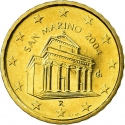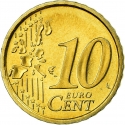You are about to finish your registration. Please check your mailbox (including spam folder). There should be a letter with a confirmation link. Check setting to make sure that your e-mail address is correct.
Send letter again
Obverse

|
The Church and the Convent of St. Francis below the country name and date, surrounded by the twelve stars of Europe. The mintmark (R) on the left, the initials of the designer and engraver below. SAN MARINO 2017 |
|---|---|
Reverse

|
A geographical map of Western Europe spans the outer ring and inner core on the left side of the coin. 10 |
| Edge |
10 Euro Cent
KM# 558
Characteristics
| Material | Nordic Gold |
| Weight | 4.1 g |
| Diameter | 19.75 mm |
| Thickness | 1.93 mm |
| Shape |
|
| Alignment | Medal |
| Mint |
Italian State Mint and Polygraphic Institute (IPZS)
|





